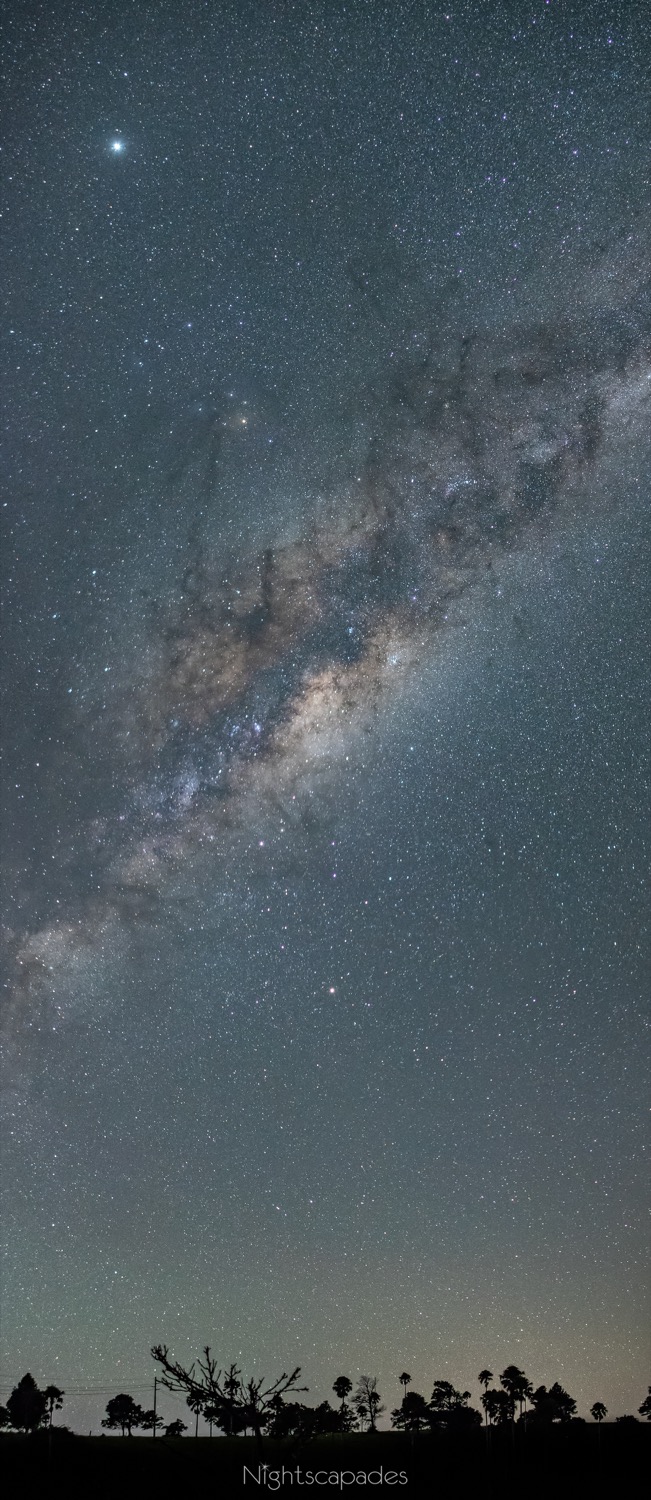
Rising Lights
Jupiter, Saturn & Mars were lined up in the eastern sky when I captured this scene. The location is Jerrara, a dairy farming area on the southeast coast of Australia and a little over an hour’s drive from my home in the southern suburbs of Sydney.
The vertical panorama was created from four overlapping images, each shot with a Canon EOS 6D Mark II camera, a Rokinon 24mm lens @ f/2.4, for an exposure time of 13-seconds @ ISO 6400.

Blood orange
In the same way that the bending (refracting) of light at sunrise and sunset gives the sky a red colour, sunlight refracted by the Earth’s atmosphere tints the Moon with this copper-coloured visage during a lunar eclipse’s “totality” phase.
Shots like this of the orange-red moon against a black sky are probably the most common type of photo I’ve seen of total lunar eclipse events. My preference is to capture images that include a terrestrial scene in them as well as the moon. Still, I find something engaging and intriguing about these moon-and-sky shots, and so chose to include this one of the total lunar eclipse of July, 2018.
Captured with a Canon EOS 6D, Sigma 50-500mm lens @ 500mm @ f/6.3 with a 0.8-second exposure @ ISO 3200.

Uprising
This image is a stitched vertical panorama created from five overlapping photos. The Milky Way was doing its thing for another night, while local fishermen did their thing on the rock shelf below. The white glow down there on the right is from the headlamps worn by the fishos, while the red arc is from where one of them cast his line into the water, its attached glowing float on heading for another session of bobbing on the waves.
The big section of rock shelf closer to the camera was pock-marked with small pools of seawater, and some of them reflected starlight back towards me, only barely showing up in the photo.
Each of the five images used to create the panorama was captured with a Canon EOS 6D MkII camera, a Rokinon 24mm lens @ f/2.4, exposed for 15 seconds @ ISO 6400.

Bend and stretch, reach for the stars
I’ve used poplars to frame the Milky Way in several shots over the past four years, and I continue to find them useful. Perhaps it’s because they’re not native trees to Australia, or because they are much taller than other trees of the same width. The warped perspective from using a wide-angle lens seems to be bending the trees towards the mass of light and gravitational attraction present in the galactic core. The location, southwest of Nowra, Australia, was another gem with clear skies, no wind and only three cars passing me in the two hours that I was lurking in the dark with my camera. I just managed to sneak Jupiter into the right-hand edge of the shot, but Mars and its blazing orange light dominate the relatively empty section of sky at the top left. This shot doesn’t quite nail the alignment I was after, and I didn’t manage to get the lighting even across all of the poplars, so I hope you find beauty and interest in it.
I used the app Autopano Pro to stitch together five single, overlapping photos to create this final vertical panorama. For each photo, I used the following equipment and settings: Canon EOS 6D Mk II camera, Samyang 14mm XP lens @ f/2.8, 25-second exposure @ ISO 6400.
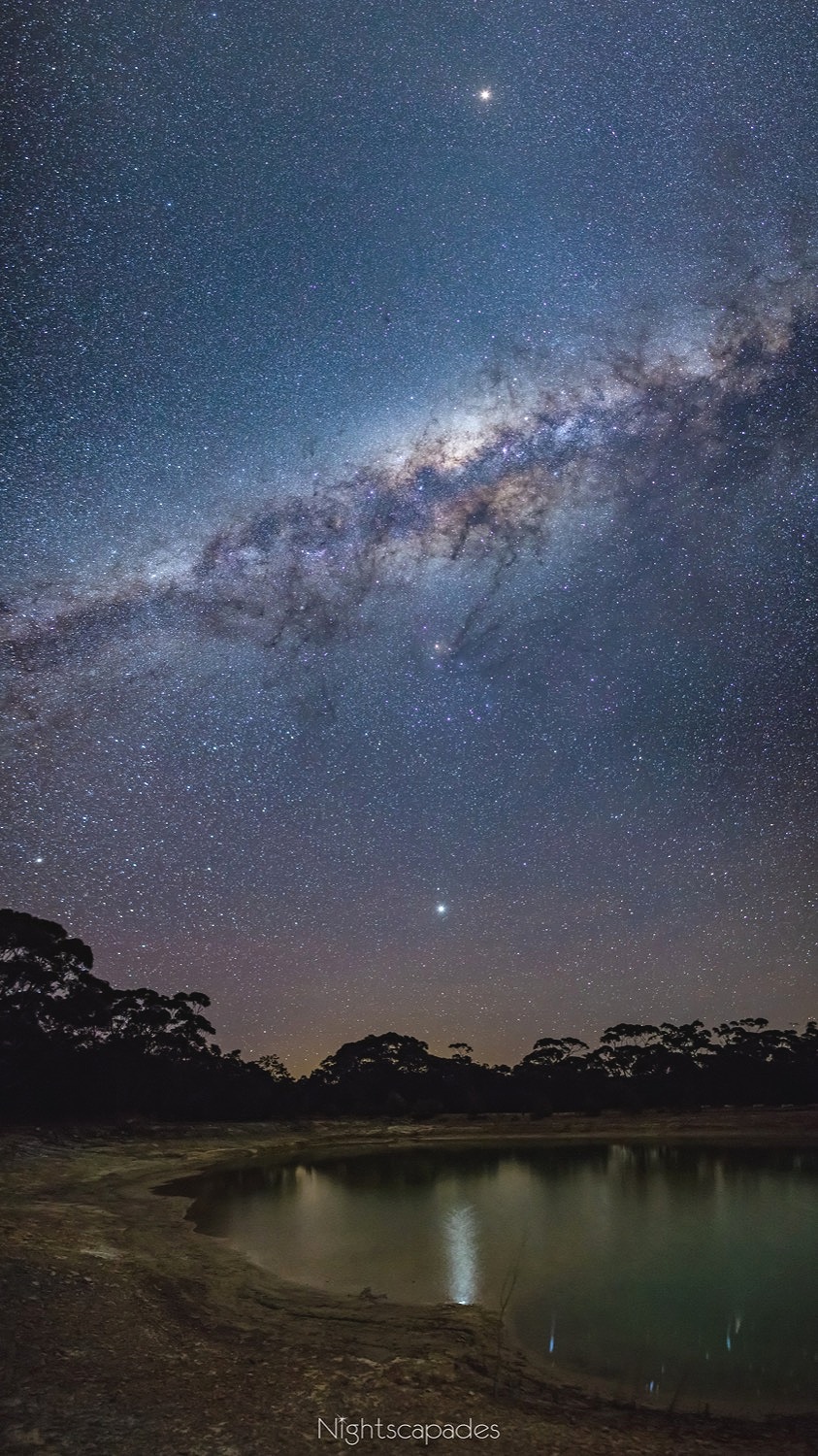
Jupiter, reflected
Our solar system’s most massive planet, Jupiter, was slipping towards the western horizon when I captured this scene at around 12:30 am on July 14 of this year. There was a stiff breeze blowing across the top of this man-made pond, causing the water to be anything but smooth, and so diffusing the reflection of Jupiter’s light. That light had travelled across close to 737 million km (458 million mi) of space to reach the pond’s shimmering surface before bouncing the few metres up to my camera.
Dwarfing Jupiter in size, magnetic field, brightness and every other aspect is the central band and galactic core of our Milky Way galaxy, owning the top 1/3 of my photo. The sky was exceptionally clear and dark on this night, enabling me to capture lots of fine details in the wisps and filigrees of the Milky Way’s “dust lanes”.
This photo was created from nine overlapping frames. I shot each of those individual photos with a Canon EOS 6D camera, a Rokinon 24mm f/1.4 lens @ f/2.4, exposed for 15 seconds @ ISO 6400. I used a Nodal Ninja 3 panoramic head, tipped on its side, to take the nine photos with enough overlap between them to create a smoothly stitched vertical panorama.

Amber airglow
Something that amazes me is the fact that you can see details of the bright, starry galactic core of our Milky Way, reflected off the water. Those photons have travelled about 27,000 light-years across space but still have enough energy to bounce off the water’s surface. Single stars are mirrored, too, like the blue star on the middle right. Its reflection is far more prominent than the original blue dot itself. This photo was captured at Black Head, a landmark of the town of Gerroa, on Australia’s south-east coast.
I used a Canon EOS 6D camera, fitted with a Canon 40mm STM lens @ f/2.8, for an exposure length of 10 seconds @ ISO 12800.
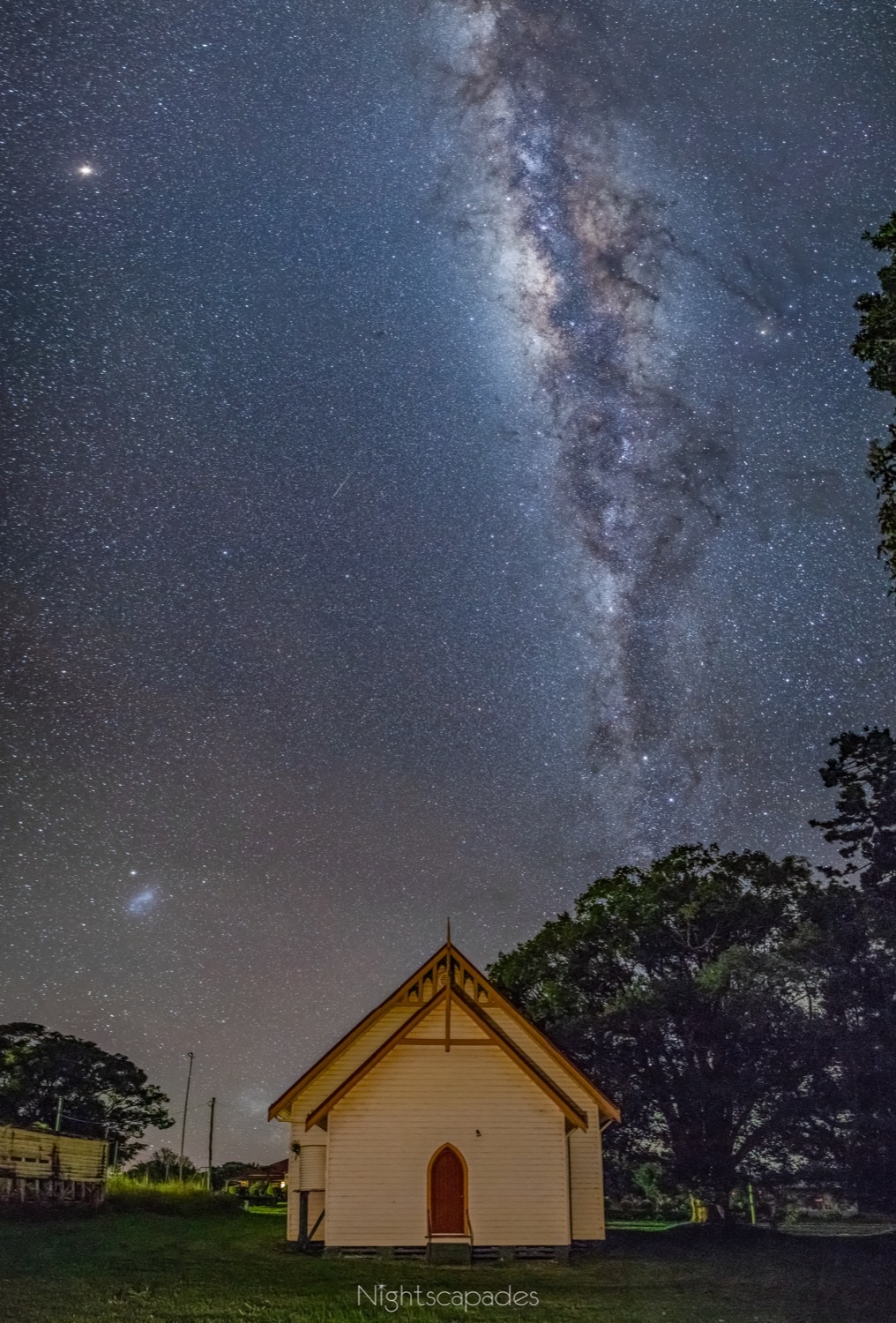
The heavens at halfway
Not quite halfway, but it was only a week after the midpoint of 2018 when I was out in the cold of an Aussie winter night, capturing the photos that I used to create this vertical panoramic image. Located near the rural city of Lismore in New South Wales, Australia, this old and former church building is blessed with dark skies on a moonless night. The lack of light pollution, as well as the dry and clear air on that evening, provided excellent conditions for revealing the wispy dust lanes and dark nebulae that characterise the core region of our Milky Way galaxy.
As with so many of my photos from that year, Mars is a dominant player in the scene, looking big, bright and orange over at the top-left of the frame. The Large Magellanic Cloud is peeking out from the bottom edge of the church’s roof on the left, with its sibling the Small Magellanic Cloud making a more conspicuous appearance over the tree near the lower corner of the frame. The short tail of a meteor forms a triangle with Mars and the Small Cloud. For all of the interest that these celestial objects give to the scene, it’s our majestic, magic and magnificent Milky Way that my eyes go straight to, every time I look at this photo.
As I mentioned above, this is a vertical panorama which I composited from ten single, overlapping images. For each of those individual frames I used a Canon EOS 6D Mk II camera, a Rokinon 24mm lens @ f/2.4, and a 15-second exposure @ ISO 6400. I had the camera mounted on a Nodal Ninja III panoramic head, tipped at 90 degrees to allow for the vertical orientation.

Another dam fine view
Luckily the wind that had been blowing for the previous two days abated enough for me to get some reflections of stars in the bottom-right of this pano, although they’re still not sharp. I actually got the stars of the Southern Cross reflected, and their colours show up much more prominently on the water’s surface than they do in the sky.
Look how much detail there is in the galactic core, including the “dancing horse” or “dark horse” nebula, as well as other dust lanes around the galactic centre. You can see the Large and Small Magellanic Cloud galaxies at the lower left, above the bright glow from the lights of the nearby HMAS Albatross naval aviation base. Mars is a prominent feature, and Jupiter’s white light is disappearing into the trees about one third down on the right.
A total of nine overlapping images were used to create this image, each of which I shot with a Canon EOS 6D camera, fitted with a Samyang 14mm XP lens set at f/2.8. The exposure time for each frame was 25 seconds, with an ISO setting of 6400. I processed the panorama using the stitching software Autopano Pro.

Setting stars
Shot at Gerroa, New South Wales, the image you’re looking at was created from 594 single photos taken over a three-hour period. My camera was pointing due west to capture the constellation Orion and surrounding stars as they set for the night. A slight mess-up with the settings is responsible for the gaps in the star trails.
I lit up the trees with a Litra LED lamp fitted with a 3200K filter and a diffuser. The 594 images used here were shot with Canon EOS 6D, Canon 40mm lens @ f/2.8, 15 sec @ ISO 1600.
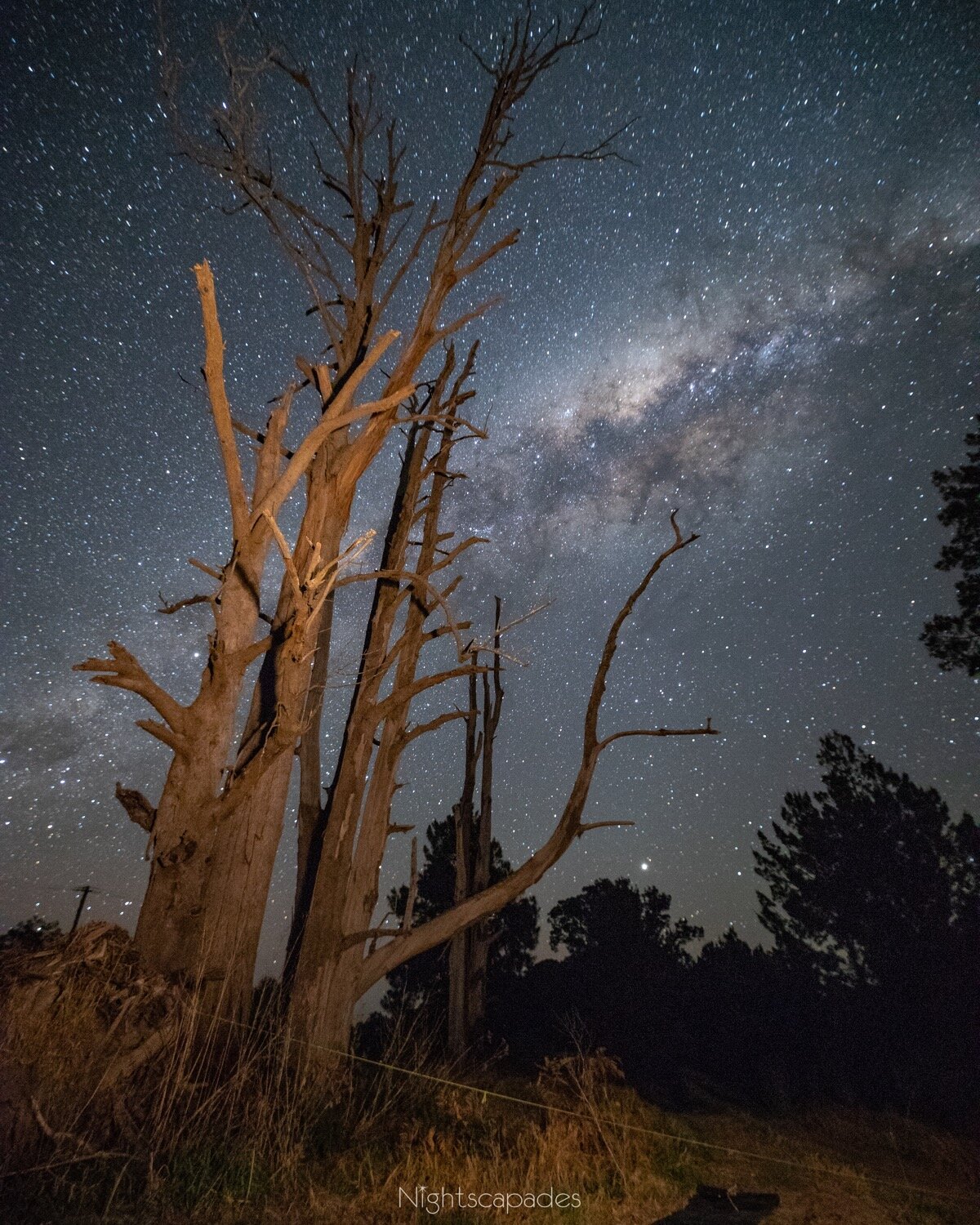
Limbs alight
I had visited this location, near the dairy town of Bodalla, several times over the past four years and I’d noticed these dead trees still reaching skywards while I was photographing other foregrounds. On this shoot, in September of 2018, I made a point of including the lifeless limbs in several photos. The yellow wire across the track wasn’t visible in the dark, but I somehow managed to avoid tripping over it during my fumbling footfalls. The bright white object near the horizon is the planet Jupiter, still surrounded by some Zodiacal Light.
This image is a single-frame photo that I shot with my Canon EOS 6D Mk II camera, a Samyang 14mm XP lens @ f/2.8, exposed for 25 seconds @ ISO 6400.

Australia Rock
Hopefully, my international followers have a least heard of Australia, if not visited here. The location of this photo was Narooma, a beautiful town on the south-east coast of the state of New South Wales, Australia. If you look at a map of Australia and then at this photo, you will see why this rock formation–actually the hole in it–is known as “Australia Rock”.
The distinctive shape weathered out of the rock is very popular for daytime photographers and is a something I’ve wanted to feature in a nightscape photo for some time. The Milky Way’s galactic core was rising at just the right time for me to stumble over the rocks, dodge a few ocean pools and then precariously balance myself and my tripod to line up the hole to frame this shot.
Less than five minutes after this a cloud front blew in from the south (right-hand side of the scene) and ended my shooting session.
This photo is a single image taken with a Canon EOS 6D Mk II, Canon 40mm @ f/2.8, 20 sec @ ISO 6400. The foreground was lit with a Manfrotto "Lumimuse" 3-led handheld lamp.

A shining sea of stars
Way out to sea and just over the horizon a cargo ship moves down the coast, its lights seeming to answer the fluorescent spill from a street light near the photographer’s position. The endless thud of waves crashing over the rocks beats a slow rhythm to mark time for the stars of the Milky Way as they make their nightly crawl across the roof of the sky. In my late childhood and early teen years, I spent lots of hours clambering over these rocks with my siblings, looking for shells, driftwood & unusual pebbles during holiday times.
The location is Tuross Head, on the southeast coast of my state of New South Wales, Australia. My children, now in their twenties, have also enjoyed many holidays at this place of peace and relaxation. None of them nor my wife have ever joined me on an outing to see and photograph the wonders of the night sky, either here or anywhere else. They’re missing out on so much!
This image is a single-frame photograph, captured with a Canon EOS 6D MkII camera, a Rokinon 24mm lens @ f/2.4, with a 13-second exposure @ ISO 6400.
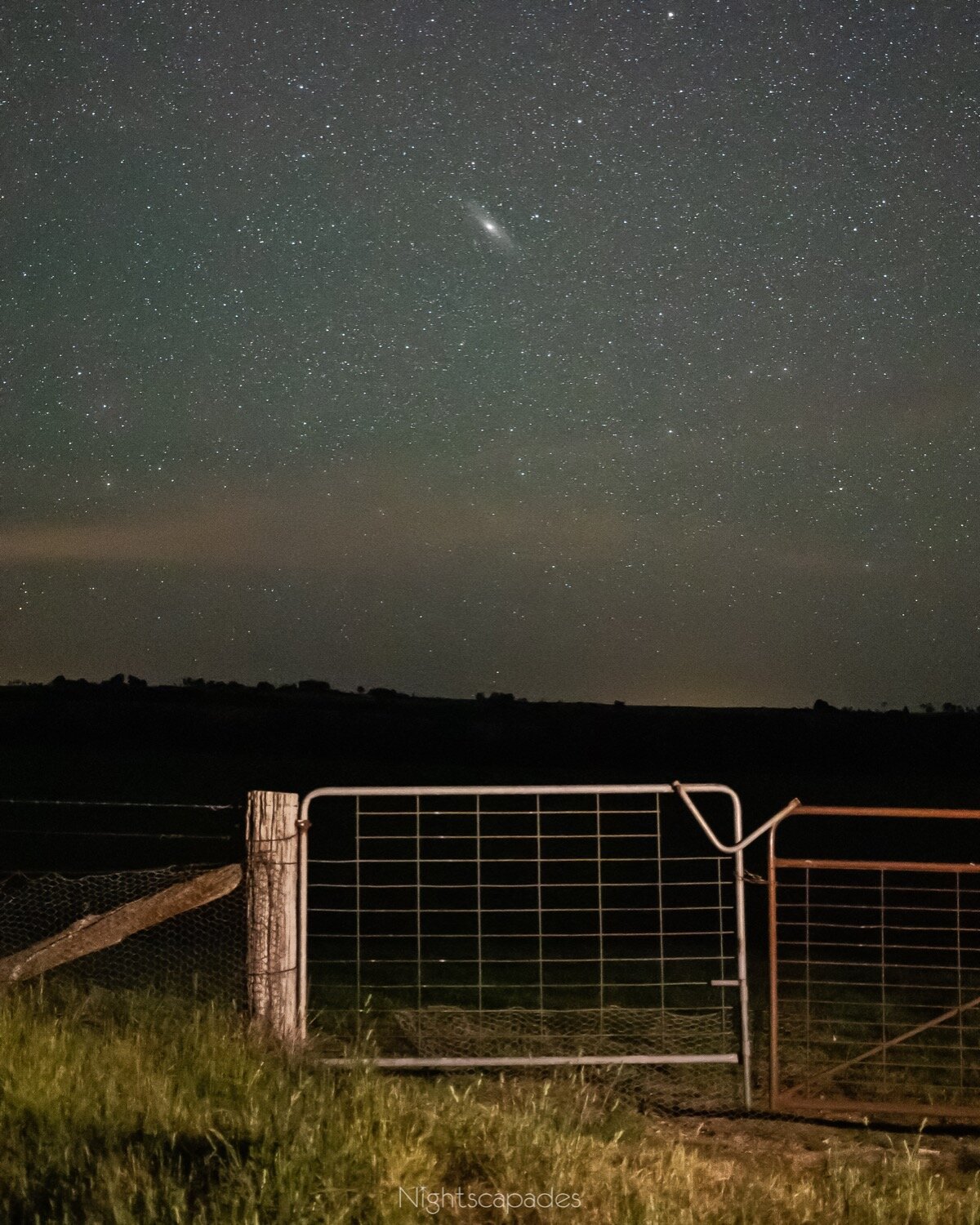
Beyond the gate
One of the most enthralling objects appearing in the astronomy books in my high school’s library was the Andromeda Galaxy. These were long-exposure images of this body of around one trillion stars, about 2.5 million light-years from Earth, captured by some of the largest and most legendary telescopes of the 20th century. Even though M31 is best seen much further north than my latitude of 34 degrees below the equator, it’s still possible to photograph this little glowing fuzzy blob low over the northern horizon. However, I didn’t use a telescope–big or small–to get this photo.
This image is a single-frame photo, captured with a Canon EOS 6D Mk II camera, a Canon 40mm lens @ f/2.8, and a 10-second exposure @ ISO 12800.
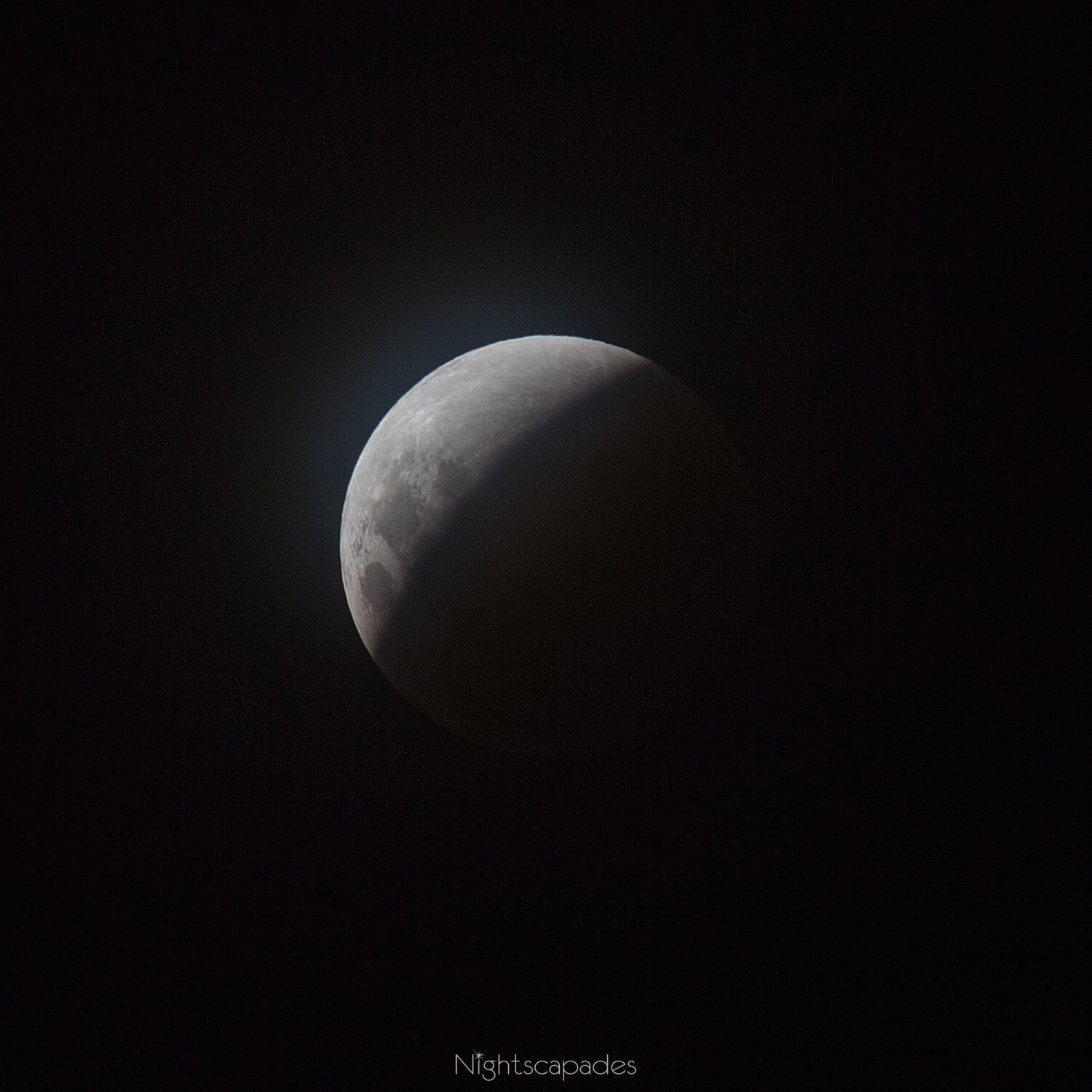
Eclipse. "To obscure or block out"
Apart from a few brief exceptions, this title describes my experience of the total lunar eclipse of late-January, 2018. The eclipse of the moon was itself eclipsed/obscured/blocked out by clouds that covered the sky from just before the eclipse started until I got home at 2:30 the next morning.
In case you’re wondering, yes, I did try hard to find some cloudless locations. How hard? 685km of driving (426mi), multiple stops to check the situation and update the weather satellite feed on my iPad. 10.5 hours from leaving home to returning and getting into bed. Better luck next time, perhaps?
A focus-stack of five shots, captured with Canon EOS 6D, Sigma 50-500mm lens @ 500mm @ f/10.0, 1/60 sec @ ISO 800.

Dam fine sky
Bamarang Dam is a secondary water reservoir, located about 10km southwest of the coastal-plain town of Nowra, on Australia’s southeast coast. The dam’s intake structure can be seen at the bottom-left, silhouetted by light spilling from the nearby HMAS Albatross naval aviation base and some coastal towns further off.
In the sky above the inlet are the Large and Small Magellanic Clouds, companion dwarf galaxies that are travelling through space with our home galaxy, the Milky Way. You can see the Milky Way itself rising almost vertically from over the dam wall and up to the top of my image. The planet Mars is dominating the top left-hand corner of the scene, and Jupiter is slipping behind the trees on the right, still over three hours from setting for the night. The background sky colour is showing the green hue of atmospheric airglow.
Each of the seven photos used to create this vertical panorama was taken using a Canon EOS 6D camera, with a Samyang 14mm XP lens @ f/3.2, for a 30-second exposure @ ISO 6400. The camera was mounted on a Nodal Ninja 3 panoramic head atop a Manfrotto tripod.

In the cold light of night
I don’t remember what the exact temperature was when I visited this shallow valley at Burrier, west of Nowra, Australia, in August of 2018. However, I do remember that the air was cold and that I was wearing multiple layers of warm clothing plus a beanie, a hoodie, gloves and had a couple of heat packs in my pockets.
This photo from that night is a stitched vertical panorama, made up from five overlapping images that I shot in the cold. The Milky Way almost bisects the scene diagonally, coming between the bright light of the planet Mars at the top and that of Jupiter below, just near the trees. I did some lighting of the foreground grass, road and trees with an LED lantern. Stray light from a nearby farmhouse did the job of lighting the fields and the thin fog that had drifted across them.
For each of the five photos that make up this image, I used a Canon EOS 6D camera mounted on a Nodal Ninja 3 panoramic head, a Samyang 14mm XP lens @ f/2.8, with an exposure time of 25 seconds @ ISO 6400.

Inner Light
In general, artificial light is not the friend of astronomers and astrophotographers. When it gets in the way of our observing or our photography, we refer to it as “light pollution”, a name that doesn’t have any hint of positivity at all.
For this photo, though, I used artificial light in the form of my LED Lenser headlamp/torch to make some inner light seem to beam and burn out from the windows of this little church. Of course, the celestial lights above the church are the reason I was at this spot taking photos, but I didn’t want to pass up the chance to give this old house of worship some inner light to brighten the scene. Although I could have captured this with a single image, I used nine shots from a 65-frame panorama that I was creating on the night.
I photographed each of those nine images with a Canon EOS 6D camera, a Rokinon 24mm lens @ f/2.4, using a 15-second exposure @ ISO 6400.

Swan trails
Living in a very light-polluted area means that I need to travel for at least 100 km (60 mi) out of my city to get somewhere with dark skies. Ideally, I should be scouting out new locations during the day and then returning later for a nightscape photography session. Due to the distances that I have to drive, plus my family & work commitments, I rarely have the time to do a daylight scouting trip as well as several hours of shooting at night.
Most of the time I head out with a knowledge of where the Milky Way’s core will be at a particular time of night, and an idea of the kind of landscape features I want to include in my photos. There will be a few possible locations in my head as I leave my driveway, but there’s also lots of map-checking and imagining of compositions on the way.
On this Sunday night in October of 2018, Swan Lake, on the southeast coast of my state of New South Wales, Australia, turned out to be a spot that ticked almost all of the boxes. The only one that didn’t score a ten was the light-pollution category, but the white glow from the tourist town of Cudmirrah, on the left of this photo, isn’t too bad.
The photo is a star-trails composite shot, created by shooting several 25-second-long images and combining them in the app “StarStaX”. I shot the original frames for a time-lapse sequence, at high ISO, so I had to pull down the highlights and push up the saturation to finish with a trails image where the stars weren’t all white and not showing their true colours.
Each photo used to create this image was taken with my Canon EOS 6D Mk II camera, through a Samyang 14mm XP lens @ f/2.8, exposed for 25 seconds @ ISO 6400.

Lines and lights
I did my best to line up the dominant elements of this photo in a zig-zag shape that starts at the top-right of the frame with the bright stars Beta and Alpha Centauri. Moving down and to the left is the thick line of stars and interstellar dust and gas of our home galaxy, the Milky Way. Following the horizon across to the right-hand side, a new sight-line begins, with the rock shelf at Black Head, Gerroa, marking the edge of the water. The planet Mars is glowing not far above the horizon in the middle of the scene, with its bright orange signature colour reflected across the water.
Jupiter stakes its claim as the brightest object in my photo, which is proper for the most massive planet in our solar system. In a line between these two and about one-quarter of that distance up from Mars, the planet Saturn is almost washed out by the light from our galaxy’s core region.
Shot with a Canon EOS 6D Mk II camera, a Samyang 14mm XP lens @ f/2.4, using a 30-second exposure @ ISO 6400.

The riches of Orion
This image of Orion and its surrounds was created using the iOptron SkyTracker and my unmodded Canon EOS 6D plus Canon 40mm STM lens. The photo shows lots of stars and some significant deep-sky features. I expected to be able to photograph M42 (Orion Nebula) and got it but it’s overexposed here. The one feature of this part of the sky that I was wanting to capture was Barnard’s Loop and I’m happy that I achieved that goal.
As well as these two wonders I snagged the Witch Head Nebula (very faint), the Running Man Nebula, IC434 & the Horsehead Nebula, plus the Flame Nebula. The Rosette and Lambda Orionis Nebulae, the much smaller and fainter vDB 38 Nebula and the Christmas Tree Cluster are also visible.
The source images for this composite were as follows:Lights: x49 frames Canon EOS 6D, Canon 40mm STM f/2.8 lens @ f/3.2, 60 second exp @ ISO 1600Darks: x5 frames Canon EOS 6D, Canon 40mm STM f/2.8 lens @ f/3.2, 60 second exp @ ISO 1600Bias: x15 frames Canon EOS 6D, Canon 40mm STM f/2.8 lens @ f/3.2, 1/4000 second exp @ ISO 1600.

Luminous Maximus
This night in September of 2018 was the first time that I had ever photographed the blue glow of bioluminescent organisms in the water here at Tuross Lake, Australia. It’s visible at the waterline on the lower left.
Overhead, distinct from the individual stars in the photo, the galactic core of the Milky Way, with its billions of suns all glowing together, is giving off a yellowish tone in the sky above the bioluminescence. High over the core is the planet Mars.
I shot each of the 18 individual frames that comprise this panorama with my Canon EOS 6D camera, a Rokinon 24mm lens @ f/2.4, using a 15-second exposure @ ISO 6400.
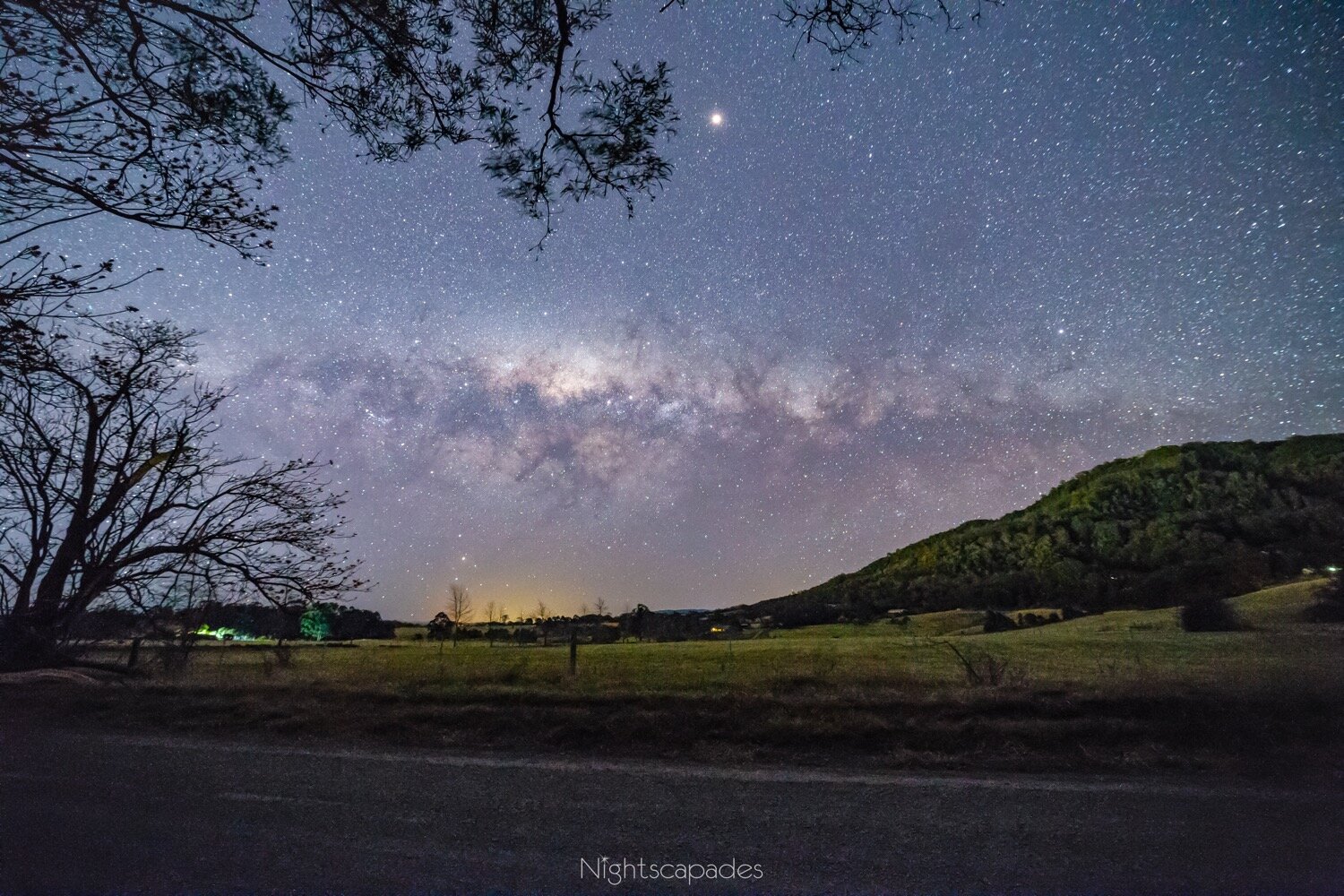
Mt Cambewarra & the Milky Way
Mt Cambewarra rises to around 680 metres (2230 feet) above sea level and provides views stretching for about 145 km (90 miles), over dairy farms, local and distant towns and out to the Tasman Sea. The nearest large town, Nowra, is only 9 km to the south (5.6 mi) and was pumping out lots of ambient light when I visited there about ten nights back. That wasted illumination is what is lighting up the foothills and southeastern face of the mountain in this single-frame photo.
Shot at around 1:30 am, my photograph captured the bright orange planet Mars riding over the Milky Way at it tipped past the horizontal, low in the southwestern sky near Mt Cambewarra.
I took this photo with my faithful Canon EOS 6D, Samyang 14mm lens @ f/3.2, using a 25-second exposure @ ISO 6400.

The Red Orb
On the eastern coast of Australia we missed out on seeing the July 2018 total lunar eclipse all the way through. The point of maximum eclipse was reached at 6:21 am, and the Moon then set at 6:55 am. Although I took lots of photos that featured Mars as well as the Moon, I’m particularly taken with this one showing the fully-eclipsed moon on its way to setting behind Seven Mile Beach, Australia. It's going to be nearly three years before the next total eclipse that's visible from my part of the world.
Canon EOS 6D, Sigma 50-500mm lens @ 161mm @ f/5.6, 1.0 sec @ ISO 3200.

Luminous Lismore
My sister-in-law and her husband live near Lismore, a major rural town in an area that has plenty of flatlands, lots of grassy hills, and everything in between. The other thing the locality has, looking in most directions, is dark skies.
The clarity and darkness of the night sky made it easy to photograph the Milky Way’s band of stars, dust and gas almost hugging the enormous leopard tree in the garden before stretching up to the northeast. Look to the top of the frame, and you'll see the familiar orange glow of the planet Mars. I repositioned my camera several times to capture Jupiter’s blue-white orb before it slipped behind the right-hand side of the tree. I mentioned that the skies are dark in most directions. The pink-white glow from the lights of Lismore, at lower right, is the reason for the “almost”.
To create this photo I shot eight single overlapping frames and then stitched those together using software called Autopano Pro. For each photo that I shot I used the following settings: Canon EOS 6D Mk II camera, Samyang 14mm XP lens @ f/2.8, with a 25-second exposure @ ISO 6400.

Stars and Wind and Light
The Pleiades star cluster–aka “The Seven Sisters” and “M45”–is a beautiful sight in the eastern skies of my Southern Hemisphere from mid-winter through until late in autumn. You can see it here in my photo, between the wind turbine’s supporting pylon and the left side of the frame. In roughly the same position on the opposite side of the tower is the inverted vee-shape that is the most recognisable portion of the constellation of Taurus, The Bull. The wind turbine–which was idle on this night, despite others nearby turning in the wind–did cut a slightly scary shape against the night sky. In the dark, it had me thinking of the “fighting machines” in HG Wells’ “War of the Worlds”.
Apart from the stars in the sky, and the headlamps of a passing car that lit up the turbine, the only other source of light I could see was the horrible, yellow-green brightness on the eastern horizon. That ghostly glow is light pollution from the city of Sydney, whose central business district is a distance of 160 km (100 mi) from where I took the photo.
This image is a single-frame photo that I shot with a Canon EOS 6D Mk II camera, using a Canon 50mm f/1.8 lens @ f/2.2, with an 8-second exposure @ ISO 6400.

Straight Outta Camera
Shot at close to 10 pm on a night in June of 2018, this scene has the Milky Way’s central band and its galactic core positioned between two rows of trees as it climbed towards the zenith. The Milky Way here serves as a dividing line between the evergreen trees on the left and the leafless deciduous ones on the right.
This stop was a hunch-stop, if you will, and paid off with some OK photos. The photo is a “sooc” shot, that is, straight-out-of-camera. The only editing I have done is to crop the photo down to fit on Instagram. I was ready to light-paint the trees and grass with a hand-held LED lamp when a car passed by on the road behind me and lit the whole area just the way I needed.
Shot with Canon EOS 6D, Samyang 14mm @ f/2.8, 25 sec @ ISO 6400.

Thanks for the inspiration!
I dedicate this photo to my fellow Australian nightscape photographer, Richard Tatti http://facebook.com/nightscapeimages. Richard lives in an area of Australia that seems to have more than its fair share of derelict, abandoned and very photogenic farm equipment and vehicles, which he uses in many of his nightscape images.
I’d failed to find any similar relics during my rural road trips, but while driving in the daytime near Nowra, New South Wales, I spotted this abandoned cart under a tree, about 50 metres from the highway. I quickly saved the GPS location, and in early 2018 made my way there after shooting at another spot about 20km away. Being near a highway the tree was lit up by passing traffic, and I got in close to light the cart with my LED lamp. You can see thick fog in the background in front of the mountain near where Mars had just risen. The moon was peeking above the eastern horizon, giving the white glow that is silhouetting the skyline. The Milky Way was its usual beautiful glowing band of light and colour in the Aussie night sky.
This single-frame image was shot with a Canon EOS 6D Mk II, Samyang 14mm XP lens @ f/2.8, 20-second exposure @ ISO 6400.

The Dead amongst the Living
The starlight that our eyes detect is what has reached us at the instant we are looking, after having travelled through space for varying distances over proportional lengths of time. If a star is four light-years away, then we’re seeing the light as it was four years ago when it left that star. If a hundred light-years distant, then our view is of one hundred year-old light. A simple look at the numbers says that at least some of the stars in this photo are dead now, despite looking alive and alight to us. As with the trees, there are many dead stars amongst the living.
A single frame, shot with Canon EOS 6D, Samyang 14mm @ f/2.8, 30 sec @ ISO 6400.

Clouds in the treetops
The Magellanic Clouds, the two large, fuzzy and misty blobs in the sky in my photo, are usually high on the list of summer nightscape targets. For most of where Australia’s population lives, the Magellanic Clouds are visible all year round but don’t get as much photographic fame as the Milky Way’s core does.
I photographed these two dwarf galaxies in early September, 2018, as they seemingly hung in the air over the Norfolk Island pine trees at Tuross Head, Australia. I also captured some satellite trails at the right-hand edge of the shot, as well as a meteor trail flashing between two of the pine trees.
I created this image from two slightly overlapping single photos, which I shot with my Canon EOS 6D Mk II camera, through a Rokinon 24mm lens @ f/2.4, using a 15-second exposure @ ISO 3200.

Tuross Blue
My photo for today is from Tuross Head, Australia, shot in September of 2018. It was taken when most of the Milky Way’s core region was in the hazy part of the sky below ten-degrees elevation. The planet Saturn was low in the west (about 1/3 in from the right of the shot), and you can see its reflection coming right across the lake to the sand in the foreground.
The blue light at the lake’s edge is from bioluminescent organisms in the water. I enhanced the intensity of the glow by throwing and splashing water that I’d scooped from the shallows.
This photo is a single-frame image that I photographed with a Canon EOS 6D camera, a Rokinon 24mm lens @ f/2.8, using a 15-second exposure @ ISO 6400.






























